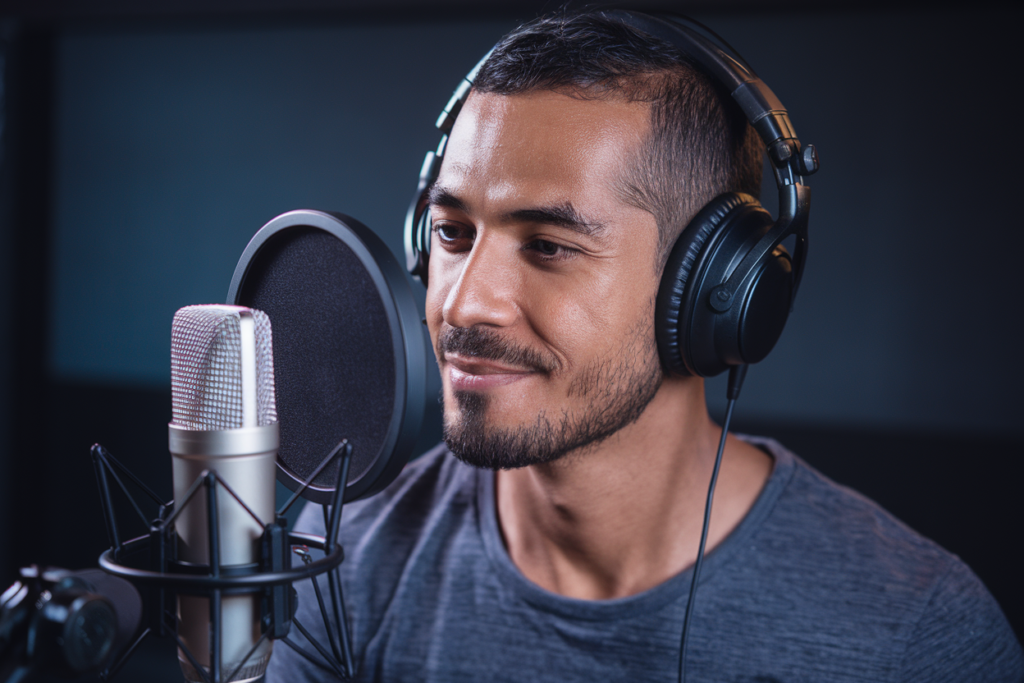Key Takeaways
- Diversity of Dialects: Arabic features over 20 distinct dialects, each with unique phonetic characteristics and cultural nuances that voice actors must master.
- Pronunciation Mastery: Accurate pronunciation is crucial as variations exist between dialects, affecting clarity and understanding in voiceovers.
- Cultural Sensitivity: Understanding cultural references and idiomatic expressions is essential for delivering authentic content that resonates with local audiences.
- Technical Quality Matters: High audio quality and the right software tools are vital to ensure clear, professional-sounding recordings that enhance emotional impact.
- Continuous Learning: Ongoing training through courses and resources focused on Arabic dialects can significantly improve a voice actor’s skills and effectiveness.
- Collaboration with Natives: Partnering with native speakers helps capture the essence of specific dialects, ensuring authenticity and relatability in voiceover projects.
Ever tried to capture the essence of Arabic dialects in a voiceover? It’s trickier than it sounds. With over 20 distinct dialects, each with its own nuances and cultural references, voiceover artists face unique challenges that can make or break a project.
Navigating these dialects isn’t just about pronunciation; it’s about conveying emotion and authenticity. You might wonder how to connect with diverse audiences while staying true to the language’s rich heritage. Whether you’re an aspiring voice actor or a producer looking for insights, understanding these challenges is key to delivering compelling content that resonates with listeners across the Arab world. Let’s dive into the complexities of voiceover work in Arabic and explore how to overcome them effectively.
Overview of Voiceover in Arabic Dialects
Voiceover in Arabic dialects presents a unique set of challenges and opportunities. With over 20 distinct dialects, each one carries its own nuances, expressions, and cultural references that a voice actor must master. You’ll find that the diversity among these dialects creates both complexity and richness in voice work.
Understanding regional variations is crucial for any voice talent aiming to connect authentically with their audience. For instance, Egyptian Arabic differs significantly from Levantine or Gulf Arabic. These differences influence pronunciation, tone, and even emotional expression. A great voice artist adapts their style to reflect these subtleties while maintaining clarity and engagement.
Emotion plays a key role too. It’s not just about getting the words right; it’s about conveying feelings that resonate with listeners. Whether you’re working on an advertisement or an educational video, your choice of dialect can impact how the message is received. Authenticity builds trust with audiences who are deeply connected to their local language variations.
Moreover, cultural references often embedded within these dialects require careful consideration during production. Familiarity with local customs or slang enhances relatability and effectiveness in delivering content across different regions.
Navigating these complexities demands skilled voice actors who grasp both linguistic elements and cultural contexts. By honing your craft to embrace the rich tapestry of Arabic dialects, you establish yourself as a versatile performer capable of reaching diverse audiences effectively.
When selecting a voice over talent for projects involving Arabic content, keep in mind their familiarity with specific dialects relevant to your target demographic. Engaging someone who understands not only the language but also its cultural intricacies can elevate your project significantly.
Common Voiceover Challenges
Voiceover work in Arabic dialects comes with unique challenges. Understanding these hurdles helps you appreciate the nuances involved in delivering authentic voiceovers.
Dialect Variability
Arabic boasts over 20 distinct dialects, each offering varied phonetic characteristics and expressions. For instance, Egyptian Arabic sounds quite different from Levantine or Gulf Arabic. Recognizing these differences is crucial for voice artists aiming to connect with their audience effectively. You might ask yourself: how does one choose the right dialect for a specific project? Selecting the appropriate variation not only impacts relatability but also ensures that your message resonates deeply.
Pronunciation Differences
Pronunciation varies significantly across Arab regions, affecting how words are articulated and understood. Certain letters may have distinct pronunciations in different dialects, leading to potential misunderstandings if not executed properly. Voice actors must master these subtleties to deliver clear and accurate voiceovers. It’s essential to practice regularly and seek feedback from native speakers for continuous improvement.
Cultural Nuances
Cultural references embedded within various Arabic dialects can pose additional challenges for voice talent. Each region carries its own set of idioms, sayings, and cultural context that enrich communication but can confuse those unfamiliar with them. Successful voiceover work requires an understanding of these cultural elements to ensure authenticity and connection with the intended audience. When selecting scripts or creating content, consider how well they align with regional sensibilities—this awareness enhances overall impact and relatability in your projects.
Technical Aspects of Voiceover
Voiceovers in Arabic dialects come with unique technical challenges that require attention to detail. Understanding these nuances can enhance the final product significantly.
Audio Quality Issues
Audio quality plays a pivotal role in voiceover projects. Background noise, echo, and distortion can distract from the message. When working with different Arabic dialects, you might notice variations in pronunciation that need clear representation. Using high-quality microphones and soundproofing techniques helps minimize distractions, ensuring your voice talent sounds crisp and professional. Additionally, monitoring levels during recording prevents clipping or muffled audio, which could undermine the emotional impact of your project.
Software and Tools
Choosing the right software is essential for any voiceover artist aiming to produce high-quality recordings. Many professionals rely on digital audio workstations (DAWs) like Adobe Audition or Audacity for editing their tracks effectively. These tools allow you to manipulate frequencies and remove unwanted noises seamlessly. Plugins designed for vocal enhancement can also add warmth and clarity specific to certain dialects. Familiarizing yourself with various features will streamline your workflow and improve overall production quality.
Investing time in understanding both audio quality issues and software capabilities ensures your voiceovers resonate authentically with listeners across diverse Arabic-speaking audiences.
Solutions and Best Practices
Understanding the complexities of Arabic dialects in voiceover work helps you navigate challenges effectively. Implementing a few solutions and best practices can enhance your projects’ authenticity and appeal.
Training and Resources
Investing time in training is crucial for voice actors aiming to master Arabic dialects. Utilize online platforms that offer courses focusing on pronunciation, intonation, and emotional delivery specific to various dialects. Engage with resources like books or videos featuring native speakers to familiarize yourself with regional nuances. Regular practice through exercises designed for articulation can refine your skills significantly. Joining workshops or webinars led by industry experts also provides valuable insights into mastering these dialects.
Collaboration with Native Speakers
Collaborating with native speakers stands as one of the most effective strategies for achieving authentic sound in your voiceovers. Partnering ensures you accurately capture the subtleties of specific dialects. Seek feedback on your recordings from individuals familiar with the target audience’s cultural context, which enhances relatability and connection. Engaging in conversation with native speakers allows you to grasp idiomatic expressions that might not translate directly but carry significant meaning within their culture. This collaboration enriches your understanding, making it easier to convey genuine emotions through your performance.
Incorporating these solutions into your workflow paves the way for producing high-quality voiceovers that resonate deeply with audiences across diverse Arabic-speaking regions.
Conclusion
Navigating the complexities of Arabic dialects in voiceover work is essential for achieving authentic and relatable recordings. By understanding the unique characteristics of each dialect and investing time in mastering pronunciation and emotional delivery, you can significantly enhance your connection with listeners. Collaborating with native speakers not only enriches your performance but also deepens your appreciation for cultural nuances.
Incorporate best practices like high-quality audio equipment and effective editing software to ensure clarity in your recordings. With dedication to honing your skills and embracing regional variations, you’ll be well-equipped to produce compelling voiceovers that resonate across diverse Arabic-speaking audiences. This journey not only elevates your craft but also honors the rich heritage of the Arabic language.
Frequently Asked Questions
What are the main challenges of capturing Arabic dialects in voiceover work?
Capturing Arabic dialects poses challenges due to the existence of over 20 distinct dialects, each with unique nuances. Voice talent must master pronunciation and convey emotion authentically. Understanding regional variations is crucial for connecting with audiences, as differences in tone and expression can significantly affect message reception.
Why is selecting the right Arabic dialect important?
Choosing the correct Arabic dialect impacts relatability and how effectively a message resonates with listeners. Different dialects can convey various cultural references and emotional tones, making it essential for voice actors to select a dialect that aligns with their target audience.
How do pronunciation differences affect voiceover work?
Pronunciation variations among different Arabic dialects can lead to misunderstandings if not accurately portrayed. Mastering these subtleties through practice and feedback from native speakers ensures clarity and enhances overall communication effectiveness in voiceover performances.
What technical aspects should be considered in Arabic voiceovers?
Quality audio is vital in voiceover work; background noise, echo, or distortion can detract from the message. Using high-quality microphones and soundproofing techniques improves clarity, while software like digital audio workstations (DAWs) aids in effective editing and vocal enhancement.
How can aspiring voice actors improve their skills in Arabic dialects?
Aspiring voice actors should invest time mastering pronunciation, intonation, and emotional delivery through online courses featuring native speakers. Collaborating with native speakers provides valuable feedback on subtle nuances and idiomatic expressions essential for authentic performances.







